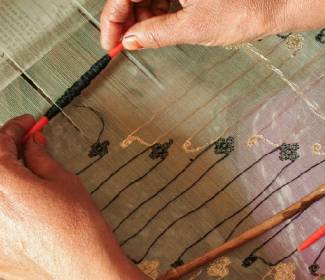
Since the days of the Indus Valley civilization, India has had a rich history of being a force in the handloom sector. Be it the Jamawar of Kashmir or the Kasavu of Kerala, each state pays homage to the multiplicity of Indian cultures through its handloom production.
The Handloom Sector – An Overview
After agriculture, the handloom sector is the 2nd largest income generating activity in the country. The industry has negligible power usage, low environmental concerns, and high potential for innovation. Households are the basic unit of production, and all members of the family engage at multiple stages of the value chain, which is inherently decentralized throughout India. It is primarily rural, and is almost wholly unorganized in nature. Its uniqueness lies in its domestic value chain and a traditionally strong base of raw material, with this distinction ensuring that India continues to be a highly attractive investment destination for the foreseeable future.
Under the India Handloom Brand, a total of 1590 registrations have been issued under 184 products categories, and more than 22,000 registrations have also been issued up to 31 March 2020 under the Handloom Mark. The production of handlooms in 2018 to 2019 was 49,476 crore, and Indian handicrafts and handlooms are INR 24,300 crore industry as of 2021 March.
As per the Fourth All India Handloom Census, the number of households engaged in handloom activities was 31.45 lakhs. In fact, nearly 15% of cloth production in India is from the handloom sector. According to the Directorate General of Commercial Intelligence and Statistics, the export of handloom products from India was valued at $343.69 mn in the financial year 2019, with the US, UK, Italy, and Germany, being pertinent importers.
Growth Drivers and Key Clusters
The handloom industry is labor intensive, and India’s young workforce is a driver for growth. The industry also sees high participation from women, especially as allied workers. The number of workers in the sector between 2009-2010 and 2019-2020 has increased by 11.5%, with a corresponding increase in total production output.
A large number of handlooms are located in the north-eastern region of India, with Assam accounting for almost half in the country. The North Eastern Region Textile Promotion Scheme has been especially potent in developing the handloom sector in the region. States like Andhra Pradesh, Uttar Pradesh, Orissa, and Tamil Nadu, also have numerous weaving centers, mostly focused on the domestic market.
While the COVID–19 pandemic and the subsequent lockdown has caused strife in the sector, the existence of excellent on-ground field support and deft maneuvering by the Ministry of Textiles has stabilized the situation. However, lack of awareness of governmental schemes and the dearth of input materials from subsidy shops are cause for malcontent. Institutional frameworks are not immune to rusting, and policies must be vigorously updated to reflect the needs of the industry.
Pertinent Reforms
In harmony with the concept of ‘Minimum government and maximum governance’, the All-India Handloom Board was abolished in July 2020. However, other institutional frameworks exist to support the industry.
- The National Handloom Development Programme
- Provides concessional credit, marketing assistance, and logistical support.
- Promotes supply schemes and the E-Dhaga mobile app.
- The Comprehensive Handloom Cluster Development Scheme
- Develops mega handloom clusters, and provides relief to MSMEs as a grant.
- The Yarn Supply Scheme
- Increase availability of yarns to eligible handloom weavers.
- The Handloom Weaver’s Comprehensive Welfare Scheme
- Assists weavers in availing social security benefits.
India’s soft power in an increasingly multipolar world will be determined by the success of its handlooms. These symbols of shared cultural expression, often touted by the Indian government through ‘Saree’ and ‘Khadi’ diplomacy, showcase the mastery of Indian weavers on the world stage, and reiterate India’s attractiveness as an investment destination for global investors.
This blog is authored by Manaved Nambiar.
- http://texmin.nic.in/sites/default/files/AR_MoT_2019-20_English.pdf
- http://www.dgciskol.gov.in
- https://tradestat.commerce.gov.in/eidb/default.asp
- https://www.indiahandloombrand.gov.in/
- https://www.ibef.org/exports/handloom-industry-india.aspx
- http://www.ficciflo.com/wp-content/uploads/2019/03/Indian-Handloom-Industry-Final.pdf




